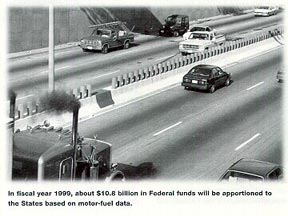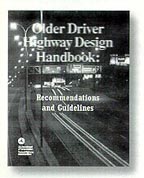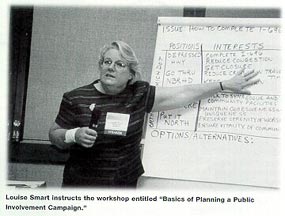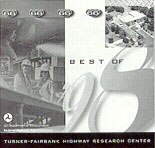U.S. Department of Transportation
Federal Highway Administration
1200 New Jersey Avenue, SE
Washington, DC 20590
202-366-4000
Federal Highway Administration Research and Technology
Coordinating, Developing, and Delivering Highway Transportation Innovations
|
Research & Technology Transporter This newsletter is an archived publication and may contain dated technical, contact, and link information. |
|
| Publication Number: N/A Date: January 1999 |
Publication Date: January 1999
|
The Federal government, as stipulated in the Transportation Efficiency Act of the 21st Century (TEA-21), relies on the States to report motor-fuel consumption and related Highway Trust Fund contributions so that the they can issue the appropriate amount of Federal-aid funds back to the States. In fiscal year 1999, about $10.8 billion in Federal funds will be apportioned to the States based on this motor-fuel data. To ensure that the data is as accurate as possible, FHWA is reviewing its current motor-fuel data reporting structure and examining other issues involved in the reporting process.

The review is being conducted in cooperation with the American Association of State Highway Transportation Officials (AASHTO) and the Federation of Tax Administrators. A group of representatives from 10 States, including revenue and transportation departments and FHWA field offices and headquarters, are participating in this effort. The group first met in Washington, D.C., in December 1998 and is chaired by FHWA North Carolina Division Administrator Nicholas L Graf. The group was addressed by FHWA Associate Administrator for Policy Dr. Walter L. Sutton Jr and Director of the Office of Highway Information Management Gary E. Maring.
By examining several aspects of the reporting process - such as differences among State motor-fuel legislation and data modeling - the group is helping States and FHWA improve the accuracy, consistency, and overall quality of State-reported motor-fuel data and related tax receipts.
In related work, FHWA also explained the method used by the agency to attribute the estimated Highway Account of the Highway Trust Fund payments to the States. This method is described on the Office of Highway Information Management's Web site, www.fhwa.dot.gov/ohim, under "Products and Publications, Highway Information Updates," Vol.3 #1, August 3, 1998.
Tom Howard (202) 366-0170 tom.howard@fhwa.dot.gov
Over the past two years, FHWA has undertaken a complete reassessment of the Highway Performance Monitoring System (HPMS) database which is used for reporting conditions and performance of the Nation's highways to Congress, developing performance indicators in support of the agency's strategic and performance plans, providing accurate data for use in meeting the fund apportionment requirements of TEA-21, and as a principal source of data for Highway Statistics and other FHWA publications. A final report on the reassessment was published in December 1998 and is available on the Internet at www.fhwa.dot.gov/ohim. A formal roll out is being made at the Transportation Research Board annual meeting in January 1999.
HPMS was developed in 1978 as a national highway database, replacing several uncoordinated annual State data reports and biennial special studies. In 1996, the need to reassess HPMS was identified. Driving factors behind the reassessment included the emerging importance of data requirements in the impending reauthorization of the Federal-Aid Highway Program; changing Federal, State and local data needs; the development and deployment of Intelligent Transportation Systems (ITS); requirements of the Government Performance and Results Act (GPRA); and States' increased use of management systems.
As a result of the reassessment, FHWA will make several notable changes to the HPMS. Over 15 percent of the data items are being eliminated and another 15percent are being changed to significantly reduce the number of detail lines. HPMS sample size reductions are proposed; and the summary of crash data by functional system is being eliminated. Concurrent FHWA activities include providing States with user friendly PC-based data submittal software and the development of Internet access to the HPMS data. Overall, the changes are expected to result in a meaningful reduction in burden for data providers while still meeting the stated HPMS goals and objectives, FHWA's future business needs, and our partners' and customers' information needs.
Four Implementation workshops will be completed during the first three months of 1999. Implementation guidance will be made available to HPMS data providers. The changes to the HPMS will take effect with the submittal of 1999 data in June 2000.
James Getzewich (202) 366-0175 jim.getzewich@fhwa.dot.gov
Since the late 1980's, FHWA has sponsored a high-priority research program that strives to improve safety and mobility for older drivers. The results and findings of that program have been synthesized in the Older Driver Highway Design Handbook (FHWA-RD-97-135), which offers highway designers guidance on how to accommodate the special needs of older motorists in their work.

FHWA issued the handbook in January 1998 and has fulfilled requests from a wide variety of users. In conjunction with the handbook, FHWA has developed and is presenting workshops to alert highway designers and traffic engineers to the needs of older drivers and to assist these designers in applying the recommendations listed in the handbook. FHWA has conducted four workshops to date and more are planned. The complete version of the Older Driver Highway Design Handbook will be available on the TFHRC web site (www.tfhrc.gov) shortly.
FHWA is also producing a more concise document, which focuses on recommendations with less emphasis on background information. It will be available in early 1999.
To order copies of the Older Driver Highway Design Handbook, call the FHWA Reports Center at (301) 577-0906.
Tim Penney (202) 493-3368 tim.penney@fhwa.dot.gov
At the confluence of the Allegheny, Monongahela, and Ohio rivers in Pittsburgh, PA, FHWA held the 14th Annual U.S.-Japan Bridge Engineering Workshop in November. The week-long workshop was established in 1984 to foster a better relationship between bridge engineers from the United States and from Japan.

The workshop allows private and public sector engineers to discuss technological advancements made for improving the longevity and durability of bridges. This year's workshop focused on improving the earthquake response of bridges and on the advancement and use of high- performance steels to improve bridge durability.
Participants during the first half of the workshop discussed information and technologies that will significantly advance the behavior and performance of bridges in the United States and Japan. The second half of the workshop consisted of field-study tours to bridges in Pittsburgh, PA; Weirton and Morgantown, WV; and Nashville, TN.
In Pittsburgh, participants studied the rehabilitation of the Fort Pitt Bridge. The arch-suspended truss bridge, with average daily travel of 150,000 vehicles, will be closed for 2 years while the decking system is replaced.
The 1995 rehabilitation of Gustave Lindenthal's Smithfield Street Bridge with the linticular truss was also reviewed. The project was recognized by the American Society of Civil Engineers for its value in the restoration of one of America's historic structures. Another interesting project they studied in Pittsburgh was the rehabilitation of the Monongahela Connecting Railroad Bridge. Here, an abandoned railroad bridge is being converted for highway use. When completed it will open up commercial development of an area that was once the Jones and Laughlin steel mills. The South Tenth Street Bridge was also studied. The bridge's main suspension cables needed to be spliced and reanchored.
The study tour continued to the site of the new Veterans Memorial Bridge over the Ohio River at Weirton, WV. The group was interested in the bridge's abnormal vibrations of the cable stays. When the wind interacts with water-laden cables during rain storms, the cable stays vibrate. Several "fixes" have been advanced and tested on other cable-stayed bridges with limited success.
The study tour moved to Morgantown, WV, where workshop participants visited the facilities and laboratories of West Virginia University. The tour participants discussed the university's current research, including the use of fiber-reinforced polymer composites (FRP) and concepts for a glass bridge deck. The group then visited the site of the Wickwire Bridge, which has a 10-m span, pultruded FRP bridge deck.
The workshop participants then visited two bridges designed using high-performance steel (HPS) in Tennessee. They reviewed the first all-HPS bridge at Martins Creek near Nashville. The use of HPS resulted in a 24 percent weight reduction of steel, an overall 11 percent cost savings for structural steel, and an overall project cost reduction of 6.5 percent. The group then viewed a second HPS bridge project under construction near Rugby, TN. This bridge is a hybrid of HPS and normal weathering steel. Here, the advantages of both materials are optimized, which should result in greater savings without compromising the bridge's durability or performance.
Jim Cooper (202) 493-3023 jim.cooper@fhwa.dot.gov

What exactly happens to pavement when it freezes? Since answers to that question differ greatly, FHWA sponsored an expert's workshop on the subject of ice mechanics and concrete deterioration at Dartmouth College during December. The workshop, organized by Erland Schulson of Dartmouth's Thayer School of Engineering and Dr. Charles Korhonen of the Cold Regions Research and Engineering Laboratory of the U.S. Army Corps of Engineers, reviewed the state-of-the-science of portland cement concrete's frost resistance. The review was conducted in light of recent advances in ice mechanics, physics theory, and measurement techniques.
The group, which consisted of 14 experts on ice mechanics and concrete, was made up of researchers from the United States, Canada, and Europe.

The meeting revealed that an uncertainty in fundamental knowledge of this subject exists:
Richard A. Livingston (202) 493-3063. dick.livingston@fhwa.dot.gov
A new contest offers students at campuses around the world an opportunity to influence the pavement design and maintenance strategies of the future. Designed primarily for engineering students and sponsored by the American Society of Civil engineers (ASCE) and FHWA, the contest involves using data from the Long-Term Pavement Performance (LTPP) studies. Students, who are encouraged to team with a highway agency or a consulting firm, determine the research objective, conduct the research, and analyze the LTPP data. The findings are then submitted in the form of a paper for evaluation.
Each participating team is given a copy of LTPP's DataPave software, which provides information about traffic, materials, performance, and environmental factors from more than 2,400 LTPP test sections on in-service highways across the United States and Canada. The contest will put this data in the hands of students and professors for the first time, creating the opportunity for its use in research, class projects, and master's or doctorate theses.
The contest, which was launched in August, will run through the spring of 1999. Currently more than 26 teams from the United States, People's Republic of China, Canada, Mexico, Brazil, Spain, Israel, and Australia have registered.
Information about the contest can be found at FHWA's DataPave Web site: datapave.fhwa.dot.gov.
Shahed Rowshan (202) 493-3152 shahed.rowshan@fhwa.dot.gov
FHWA's Special Projects and Engineering Division will display a variety of developments at the 1999 Transportation Research Board (TRB) conference, held Jan. 10-14, 1999. Attendees can stop by the HIPERPAV booth and learn about this user-friendly, WindowsT-based software, which evaluates the potential for uncontrolled cracking of concrete pavements and debonding of bonded overlays during construction.
The Division's latest summary report Joint Sawing Guidelines: The Window of Opportunity, will be available. Because of the continuing demand, this report has been printed for a second time.
The developers of the ROad Surface ANalyzer (ROSAN) will be present at the Pavement Surface Analysis lab booth. ROSAN collects pavement surface texture data, feature measurements, and road profile data at highway speeds. It has now entered into real-world service by FHWA's cooperative research and development agreement partner, Surfan Engineering and Software, Inc. Attendees can arrange with the booth staff to see ROSAN at TFHRC or to meet with developers for one-on-one discussions. Limited transportation to TFHRC will be provided during the conference.
The Nondestructive Evaluation booth will display the latest bridge technologies and introduce TFHRC's state-of-the-art Validation Center.
A copy of the User Guidelines for Waste and Byproduct Materials in Pavement Construction will also be available on paper, or pick up a copy on CD-ROM at the Recycling Booth. The manual provides information on 19 waste or byproduct materials and addresses their use in six pavement construction applications. Attendees can also pick up information about the newly established Recycled Materials Resource Center at the University of New Hampshire.
FHWA has initiated development of a Special Roadway Aesthetic Treatments Photo Album Workbook. The project's goal is to compile examples of innovative aesthetic treatments that have been applied to transportation projects nationwide, with particular emphasis on structural and geotechnical features (i.e., bridges, walls, barriers, soil and rock cut and fill slopes). The workbook will include color photographs, brief project and aesthetic treatment descriptions, typical plan sheet details, construction specifications, and construction cost data.
When completed, this photo album workbook will be placed on a Web site as a multiple-use reference resource that can be used by highway designers and landscape architects when considering preliminary design alternatives and to show owner and permitting agencies, citizen groups at public hearings, and others what a particular treatment looks like. The electronic version will also allow easy incorporation of selected treatments into presentation materials and contract documents.
Aesthetic treatment examples to be included in the workbook are currently being solicited nationwide. If your agency or company would like to submit an example, please notify: Stephen Hay, GeoEngineers Inc., 7504 S.W. Bridgeport Road, Portland, OR 97224; (503) 624-9274; Fax, (503) 620-5940, shay@geoengineers.com. A completed example submission will immediately be mailed to you. The deadline for submission is March 1, 1999. All those sending treatment examples to be included in the workbook will receive a free copy of the finalized workbook and CD-ROM.
Ron Chassie (503) 326-3844 ron.chassie@fhwa.dot.gov
More than 300 communications professionals representing 180 transportation organizations came together at a national symposium, Getting Our Message Out: Elevating Public Awareness of Transportation Issue, held December 3-4 in Alexandria, VA. The symposium, the first-ever of its kind, was sponsored by DOT in partnership with 15 co-sponsoring organizations.

"Virtually everything that we are involved with requires communication with the public," said FHWA Office of Technology Applications (OTA) Director Joseph S. Toole in his welcoming remarks. "The FHWA is blessed with a large number of engineers, and communications is not our expertise. Recognizing this, the OTA strengthened our marketing and communications team, and we put our periscope up to see who else in the surface transportation community is communicating with the general public-trade and professional associations, highway and transit agencies, public relations firms, contractors, research organizations, and other modal agencies within the DOT. We've come together at this symposium to see how we can share and learn from each other. The surface transportation industry has a wonderful story to tell and we need to work together to get our message out."
Keynote speaker David Winstead, Secretary of the Maryland Department of Transportation (MDOT), cited a recent Baltimore Sunpapers poll as evidence that public awareness of the importance of transportation issues could be improved. "Better Roads" was ranked last of 16 major concerns by respondents, and "Better Transit" was ranked only 14th. He noted that AASHTO did a good job last year of stimulating public interest in transportation through its reauthorization campaign, effectively using tools such as a report on transportation and the economy to get their message out.
Alan Pisarski, author of Commuting in America, speaking in a session on "Who Is Our Public and What Are They Saying?," said that in the future, transportation investments will "have to be justified on economic and social grounds." Pisarski said that polls show most people are satisfied with their transportation system and only 10 percent travel more than 60 minutes to work. "We can't justify investments on the 'sky is falling' message," Pisarski warned.
Surface Transportation Policy Project (STPP) Executive Director Roy Kientz, speaking in the same session, agreed that most people are not that interested in transportation as an issue. "But they do care about their quality of life," Kientz said. "Our technique is to personalize everything, and then localize it. For example, the quality-of-life message we used when a national report on pedestrian safety showed that 50 percent of those injured in auto accidents are pedestrians was to translate it into 'you risk being hit and killed by a car,' and then to localize it to each of the major metro areas in the country."
ABC News Producer Tina Babarovic, speaking as part of a media panel, said broadcast news teams often have just three hours to put a story together. They appreciate news sources "who can tell us how to get quick access to people where we are" who can tell the story well. Broadcast news media also appreciate advance notice about news stories and always need good visuals, she said.
An 18-minute video was made especially for the event, which summarized practical tips for improving communications programs. Attendees each received copies of the video to take home.
Deborah Vocke (202) 366-4855 deborah.vocke@fhwa.dot.gov

The Best of '98 CD-ROM will be available in January 1999. This year's CD features a compilation of the best of the TFHRC Web site, including Developing Human Factors Guidelines for the Automated Traveler Information System and Commercial Vehicle Operations (ATIS/CVO); the Bicycle Compatibility Index: A Level of Service; the Truck Pavement Interaction information site; and a complete year of Public Roads and the R&T Transporter. Returning from its debut on the Best of '97 CD, will be the User Guidelines for Waste and Byproduct Materials in Pavement Construction.
Accompanying the Best of '98, will be the Safety '98 CD and the Advanced Research Team CD. Safety '98 is a library of documentation on projects like the Intelligent Vehicle Initiative (IVI), ATIS/CVO, Symbol Signing for Older Drivers, Pedestrian/Bicycle information, and the Speed and Speed Management report. This CD is a combined effort of FHWA's Safety Design Division and the Traffic and Driver Information Systems Division. More than 40 technical reports, guidelines, briefs, and bibliographies will be available for browsing.
The Advanced Research Team CD is a compilation of the technical reports and available software from the TFHRC Advanced Research Team. This CD includes The Wrapping Concept and Software Development; Neural Network Tools for Condition Assessment; and Detection Technology for IVHS. Limited numbers of this CD are available, so be sure to request a copy early. To order a CD-ROM, call the contact below.
Dawn Vanlandingham (202) 493-3198 dawn.vanlandingham@fhwa.dot.gov.